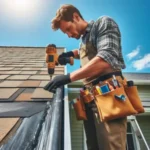Your home is your sanctuary, a place where you seek refuge from the outside world and create lasting memories with loved ones.
However, the elements—ranging from relentless rain and snow to scorching sun and howling winds—can pose significant threats to your fortress, compromising its integrity and comfort. As homeowners, it’s essential to take proactive measures to safeguard your abode against nature’s unpredictable whims. In this blog post, we will explore top strategies designed to fortify your home, ensuring it stands strong against the challenges posed by Mother Nature. From investing in durable roofing materials and energy-efficient windows to enhancing drainage systems and embracing eco-friendly landscaping, we’ll guide you through practical steps that not only protect your investment but also enhance your living environment. Join us as we delve into the best practices for creating a resilient home, so you can enjoy peace of mind and comfort, no matter what the weather brings.
1. Introduction: Understanding the Importance of Home Protection

In an ever-changing world, the importance of safeguarding your home from the elements cannot be overstated. Your home is not just a structure; it’s a sanctuary—a place where you and your loved ones seek comfort, security, and peace of mind. However, it is constantly subjected to a variety of environmental challenges, from relentless rain and fierce winds to the scorching sun and bitter cold. Each weather condition poses its own set of risks, capable of causing both minor inconveniences and major damage if left unaddressed.
Understanding the significance of a well-protected home is the first step towards creating a resilient fortress. Not only does effective protection minimize the risk of costly repairs, but it also enhances the longevity of your property. A sturdy home can withstand nature’s wrath, ensuring that your family remains safe and comfortable no matter what Mother Nature has in store.
But home protection goes beyond physical barriers; it encompasses a holistic approach to maintaining your living space. This involves evaluating potential vulnerabilities, implementing preventative measures, and regularly updating your defense strategies to adapt to changing weather patterns. Whether you live in a flood-prone area, experience heavy snowfall, or are in the path of hurricanes, tailoring your protection plan to your specific environment is crucial.
In this blog post, we will explore essential strategies to fortify your home against the elements. From reinforcing your roof and sealing windows to landscaping wisely and investing in quality materials, each tactic plays a vital role in creating a safe haven for you and your family. Join us as we delve into the top strategies for protecting your home and ensuring that it stands strong against whatever nature throws your way.
2. Assessing Your Home’s Vulnerabilities
Assessing your home’s vulnerabilities is a crucial first step in fortifying your fortress against the elements. Every home has its weak points, and identifying these areas can save you from costly damages and ensure your shelter remains a safe haven. Start by conducting a thorough inspection of the exterior; look for cracks in the foundation, gaps around windows and doors, and any signs of wear on your roofing materials.
Check for areas where water might pool, as standing water can lead to seepage and structural damage over time. Pay special attention to your gutters and downspouts—clogged or damaged systems can redirect water to your home’s foundation rather than away from it.
Next, consider the materials your home is constructed from. For instance, wooden siding may be more susceptible to rot and pests compared to vinyl or fiber-cement alternatives. If you live in an area prone to high winds or heavy snow, evaluate the strength and integrity of your roofing and siding to ensure they can withstand the elements.
Don’t forget about the interior! Look for drafts around windows and doors, as well as insulation in the attic and walls. Upgrading insulation can significantly enhance your home’s energy efficiency and temperature regulation.
Finally, consult with professionals if you’re unsure about your findings. A home inspector or a contractor can provide expert insight into potential vulnerabilities you might overlook. By thoroughly assessing your home’s weaknesses, you’ll be better equipped to implement protective measures and fortify your fortress against whatever nature may throw your way.
3. Weatherproofing Your Exterior: Doors and Windows

When it comes to fortifying your home against the unpredictable whims of Mother Nature, weatherproofing your exterior is an essential strategy that should not be overlooked. Your doors and windows serve as the first line of defense against the elements, and ensuring they are properly sealed can significantly enhance your home’s resilience and energy efficiency.
Start with your doors. Inspect them for gaps or cracks that could allow drafts to seep in. A simple yet effective measure is to apply weather stripping around the edges. This not only helps keep cold air out during the winter months but also prevents cool air from escaping in the summer, ultimately reducing your energy bills. For added protection, consider replacing hollow-core doors with solid wood or fiberglass options, which provide better insulation and durability.
Next, turn your attention to your windows. Older windows can be a significant source of heat loss, so it’s crucial to assess their condition. If you notice condensation between the panes or difficulty in opening and closing, it may be time for a replacement. Opt for double or triple-glazed windows that offer superior insulation and noise reduction. Additionally, applying storm windows can provide an extra layer of security against heavy winds and rain.
Don’t forget to check your window frames and sills. Look for any signs of rot or decay, especially in wooden frames. These can weaken your home’s structure and allow moisture to enter. Sealing any gaps with caulk or expanding foam can further enhance the moisture barrier, preventing water from infiltrating and causing costly damage.
Incorporating these weatherproofing measures will not only protect your home from harsh weather conditions but also contribute to a more comfortable and energy-efficient living space. By investing time and resources into your doors and windows, you’re fortifying your fortress against the elements, ensuring your home remains a safe haven for years to come.
4. The Role of Insulation in Home Defense
When it comes to fortifying your home against the elements, insulation plays a crucial role that often goes unnoticed. Think of insulation as the protective barrier that keeps your living space comfortable while shielding it from the harsh realities of weather fluctuations. It’s not just about shaking off the winter chill or avoiding the summer heat; effective insulation serves as your home’s first line of defense against moisture, noise, and energy loss.
A well-insulated home helps maintain a consistent internal temperature, reducing reliance on heating and cooling systems and, in turn, lowering energy bills. This is especially significant in regions prone to extreme temperatures, where inadequate insulation can lead to skyrocketing utility expenses and uncomfortable living conditions. Insulation comes in various forms—fiberglass, spray foam, cellulose, and rigid foam boards—each offering unique benefits depending on your home’s structure and your specific needs.
Furthermore, insulation acts as a moisture barrier, preventing condensation and the subsequent growth of mold and mildew, which can not only compromise the structural integrity of your home but also pose health risks to you and your family. Investing in quality insulation means investing in long-term protection for your home and well-being.
When planning your insulation strategy, consider areas that often get overlooked, such as attics, crawl spaces, and even around windows and doors. Sealing these vulnerable spots can significantly enhance overall energy efficiency. As you fortify your fortress, remember that the right insulation can make all the difference in creating a resilient home that stands strong against the elements. So, take the time to assess your current insulation and make necessary upgrades—your home will thank you.
5. Roofing Strategies for Extreme Weather Conditions

When it comes to fortifying your home against the forces of nature, the roof is your first line of defense. Extreme weather conditions—be it torrential rains, heavy snow, intense heat, or fierce winds—can take a significant toll on your roofing system. Therefore, implementing effective roofing strategies is crucial to ensure that your home remains a safe haven, no matter the weather outside.
**Choose the Right Materials:** Start by selecting roofing materials that are specifically designed to withstand your local climate. For areas prone to heavy snowfall, consider materials like metal or slate, which can handle the weight and resist cracking. In regions with high winds, such as coastal areas, opt for shingles rated for wind resistance or a roof that utilizes a low-profile design to minimize the risk of uplift. Additionally, reflective roofing materials can help combat extreme heat by reducing your home’s cooling costs in the sweltering summer months.
**regular Inspections and Maintenance:** Proactive maintenance is key to extending the life of your roof. Schedule regular inspections, especially after severe weather events, to identify and address issues like loose shingles, leaks, or damage caused by debris. Cleaning gutters and downspouts to ensure proper drainage can also prevent water from accumulating and causing structural damage.
**Consider Roof Reinforcement:** In areas frequently affected by hurricanes or tornadoes, reinforcing your roof can provide an extra layer of protection. This can involve securing the roof deck to the house frame or installing hurricane straps that help hold the roof in place during high winds. These modifications can significantly enhance your roof’s ability to withstand extreme weather conditions.
**Implement Proper Insulation and Ventilation:** A well-insulated roof not only keeps your home comfortable but also prevents moisture buildup that can lead to mold and structural damage. Ensure that your attic is properly ventilated to allow for adequate air circulation, reducing the risk of ice dams in winter and overheating in summer.
By taking these roofing strategies into account, you can better protect your home from the elements, ensuring that your fortress remains strong and secure through every storm. Remember, a resilient roof not only safeguards your property but also contributes to the overall longevity and value of your home.
6. Landscaping Tips to Shield Your Home
Landscaping isn’t just about aesthetics; it’s a powerful tool for creating a natural barrier that shields your home from the elements. By making thoughtful choices in your outdoor space, you can significantly enhance your home’s resilience against weather-related threats.
**1. Plant Strategically:** Choose trees and shrubs that can act as windbreaks, reducing the impact of strong gusts on your home. Evergreens are particularly effective, as they maintain their foliage year-round, providing a consistent shield. Position these plants on the side of your home that faces the prevailing winds to create a natural barrier that mitigates storm damage.
**2. Elevate Your Garden Beds:** When heavy rains arrive, flooding can pose a serious risk to your home. By raising your garden beds or creating swales, you can guide water away from your foundation, preventing potential water damage. Adding mulch or gravel to your landscape not only enhances drainage but also adds an attractive touch to your outdoor aesthetics.
**3. Use Native Plants:** Opt for native plants that are well adapted to your local climate. These plants require less water and are more resilient to environmental stressors, making them an excellent choice for sustainable landscaping. Additionally, native plants can improve soil stability and reduce erosion, protecting your home from the impact of heavy rains or soil shifts.
**4. Create a Rock Barrier:** Consider incorporating decorative rocks or gravel around your foundation to divert water away from your home. These elements can absorb excess moisture and prevent pooling, while also adding texture and visual interest to your landscaping design.
**5. Mulch Wisely:** Organic mulch not only enhances your garden’s appearance but also plays a crucial role in moisture retention and weed control. Applying a thick layer of mulch around your plants helps regulate soil temperature and keeps roots protected during extreme heat or cold, further reinforcing your home’s defenses against the elements.
By implementing these landscaping strategies, you’re not just beautifying your property; you’re proactively fortifying your fortress against nature’s challenges. With a well-designed landscape, you can create a harmonious balance between safety and beauty, ensuring your home stands strong against whatever Mother Nature throws its way.
7. Gutter Maintenance: Keeping Water Away from Your Foundation

Gutter Maintenance: Keeping Water Away from Your Foundation
When it comes to protecting your home from the elements, one of the most crucial yet often overlooked aspects is the maintenance of your gutters. These seemingly simple channels play a vital role in directing rainwater away from your roof and foundation, preventing costly water damage and structural problems. Neglecting your gutters can lead to a host of issues, from mold growth and rotting wood to basement flooding and foundation cracks.
To ensure your gutters are functioning optimally, start by inspecting them at least twice a year, ideally in the spring and fall. Look for signs of blockages, such as leaves, twigs, and debris that can impede the flow of water. A clogged gutter can quickly turn into a waterfall, pouring water down the sides of your home instead of directing it away. When cleaning, use a sturdy ladder and wear gloves to safely remove any buildup. It’s also wise to check for any rust or damage, as even minor issues can escalate if not addressed promptly.
In addition to regular cleaning, consider installing gutter guards. These protective covers can significantly reduce the amount of debris that accumulates in your gutters, minimizing the frequency of cleanings and ensuring that water flows freely. Another effective strategy is to ensure that your downspouts are directed away from your foundation, ideally at least three to four feet away. This simple adjustment can make a world of difference in preventing water from pooling around your home.
Furthermore, while you’re tending to your gutters, take a moment to inspect the soil around your foundation. Ensure that it’s sloped away from your home, allowing for excellent drainage. If you notice any areas where water tends to collect, consider regrading the landscape or adding drainage solutions like French drains to further mitigate water issues.
By prioritizing gutter maintenance, you not only extend the lifespan of your home’s exterior but also fortify your fortress against the relentless forces of nature. A little attention to this critical aspect of home care can save you from significant headaches and expenses down the line, ensuring that your home remains a safe haven for years to come.
8. Installing Storm Shutters for Added Security
When it comes to safeguarding your home against the unpredictable forces of nature, installing storm shutters is a strategic move that combines both functionality and aesthetics. Storm shutters are more than just a protective barrier; they serve as an essential line of defense against harsh weather conditions such as strong winds, heavy rain, and flying debris.
Available in various materials, including aluminum, vinyl, and wood, storm shutters come in a range of styles to suit your home’s design—from classic Colonial to modern minimalism. This versatility means you don’t have to compromise on curb appeal while enhancing your home’s resilience. When closed, storm shutters not only shield your windows from potential damage during storms but also provide an extra layer of security against break-ins, making your home a less attractive target for intruders.
Furthermore, storm shutters can contribute to energy efficiency. By blocking out direct sunlight, they can help regulate indoor temperatures, keeping your home cooler in the summer and warmer in the winter. This can lead to reduced energy bills, as your heating and cooling systems won’t have to work as hard.
Installation is straightforward, with options ranging from manual to motorized systems that can be deployed at the touch of a button, ensuring you’re always prepared regardless of the weather forecast. Investing in storm shutters not only fortifies your home against the elements but also provides peace of mind, knowing that your fortress is well-protected and ready to withstand whatever Mother Nature throws its way.
9. Choosing Durable Materials for Outdoor Features
When it comes to fortifying your home against the elements, the choice of materials for outdoor features can make all the difference. Opting for durable, weather-resistant materials is essential not only for longevity but also for maintaining the aesthetic appeal of your property.
Start with your deck or patio. Composite decking materials, for instance, are engineered to withstand the harshness of sun, rain, and snow without warping or fading over time. Unlike traditional wood, composites resist splintering and require minimal maintenance—just a simple wash now and then to keep them looking fresh. If you prefer natural materials, consider using treated hardwoods like teak or mahogany, which are naturally resistant to decay and insect damage.
For outdoor furniture, look for options made from aluminum or stainless steel. These metals are not only lightweight and stylish but also impervious to rust, ensuring that your investment remains intact through the seasons. Additionally, synthetic wicker can provide a chic, comfortable seating area without the worry of mold or mildew that comes with traditional wicker.
When it comes to fencing and gates, materials like vinyl or metal are excellent choices. Vinyl fencing is virtually maintenance-free and stands up to UV rays, while metal fences can provide both security and style, remaining unaffected by moisture and pests.
Finally, don’t overlook roofing and siding materials. Architectural shingles or metal roofing can offer superior protection against high winds and heavy precipitation, while fiber-cement siding is highly resistant to rot, warping, and insect damage.
By carefully selecting durable materials for your outdoor features, you not only enhance your home’s resilience against the elements but also elevate its overall curb appeal, creating a fortress that stands the test of time. Investing in quality materials is an investment in peace of mind, ensuring that your home remains a safe haven for years to come.
10. Preparing Your Home for Natural Disasters
Natural disasters can strike without warning, and being unprepared can lead to devastating consequences for your home and loved ones. To fortify your fortress against the unpredictable forces of nature, it’s essential to implement a proactive approach to disaster readiness.
Start by assessing your home’s vulnerability to the types of natural disasters most common in your area—be it hurricanes, floods, wildfires, or earthquakes. Each threat requires a tailored strategy to mitigate damage. For instance, if you live in a flood-prone zone, consider investing in raised foundations and proper drainage systems. Installing sump pumps can also help divert water away from your home during heavy rains.
For those in hurricane-prone regions, reinforcing your windows and doors with storm shutters can provide an extra layer of protection against high winds and flying debris. Similarly, securing roof shingles and ensuring your gutters are clean and functioning will help prevent water from seeping into your home during severe storms.
In the face of wildfires, creating defensible space around your property is crucial. This involves clearing flammable vegetation, maintaining a well-trimmed lawn, and using fire-resistant materials for fences and decks. Additionally, having a reliable evacuation plan and a go-bag ready with essentials can make all the difference should you need to leave quickly.
Don’t forget the importance of insulation and structural integrity in earthquake-prone areas. Investing in retrofitting your home can minimize damage and protect your family when the ground begins to shake. Regularly inspecting your home for vulnerabilities, such as cracks in the foundation or aging roofing materials, can also help you stay one step ahead of potential disasters.
Lastly, consider joining or forming a community preparedness group. Sharing resources and knowledge with neighbors can enhance your collective resilience against natural disasters. By taking these steps to prepare your home, you’re not just safeguarding your property; you’re fortifying your fortress for whatever nature has in store.
11. The Benefits of Regular Home Inspections
Regular home inspections are not just a precaution; they are a proactive strategy for safeguarding your fortress against the relentless forces of nature. These inspections provide a crucial opportunity to identify potential vulnerabilities before they escalate into costly repairs or, worse, structural failures. By enlisting a professional inspector to assess your home on a routine basis, you can uncover issues such as roof wear, foundation cracks, and water damage that might otherwise go unnoticed.
One of the most significant benefits of regular inspections is the peace of mind they offer. Knowing that your home is fortified and sound allows you to focus on enjoying your living space rather than worrying about hidden problems. Moreover, these inspections can highlight areas where your home may be vulnerable to extreme weather conditions—whether it’s reinforcing your roof to withstand heavy winds or ensuring your gutters are clear to prevent water damage during torrential rain.
Additionally, a home inspection can be a valuable tool for planning future upgrades or renovations. If an inspector identifies outdated insulation or inefficient windows, you can prioritize these improvements, enhancing your home’s energy efficiency and reducing your utility bills. This not only contributes to your comfort but also adds value to your property.
In summary, regular home inspections are an investment in your home’s longevity and your family’s safety. They empower you to take control of your living environment, ensuring that it remains a sturdy bastion against the elements while providing you with invaluable peace of mind. Don’t wait for the storm to hit—fortify your fortress with the knowledge gained from a thorough inspection today.
12. Smart Home Technology for Monitoring Weather Conditions
In today’s rapidly evolving technological landscape, smart home technology has emerged as a powerful ally in your quest to fortify your home against the elements. Imagine a system that not only alerts you to impending storms but also allows you to monitor temperature fluctuations and manage your home’s energy consumption—all from your smartphone or tablet. This level of connectivity can be both a proactive defense and a reactive response to nature’s unpredictability.
Smart weather stations are at the forefront of this movement, providing real-time data on wind speed, humidity, and precipitation directly to your devices. Equipped with advanced sensors, these stations can forecast conditions specific to your location, giving you a heads-up about potential weather threats before they strike. This means you can batten down the hatches or adjust your heating and cooling settings ahead of time, ensuring your home remains a safe haven.
Furthermore, integrating your weather monitoring systems with your home automation setup elevates your defense strategy. For instance, pairing weather alerts with smart window shades can keep your home cooler during a heatwave by automatically adjusting to block out the sun. Similarly, smart thermostats can adjust temperatures based on the forecast, optimizing energy efficiency while keeping your home comfortable.
Additionally, smart irrigation systems can help mitigate water damage during heavy rainfall by adjusting your watering schedule based on current weather conditions. This not only protects your landscaping but also prevents unnecessary flooding in your yard.
By investing in smart home technology dedicated to weather monitoring, you create a dynamic shield against the elements, ensuring your home remains resilient and secure no matter what Mother Nature throws your way. Embracing these innovations not only enhances your home’s safety but also offers the peace of mind that comes from being prepared for whatever weather may come.
13. Creating an Emergency Preparedness Plan
Creating an Emergency Preparedness Plan is a vital step in fortifying your home against the unpredictable forces of nature. While we often think about safeguarding our homes from immediate threats like storms or floods, it’s equally important to prepare for the aftermath. A well-structured emergency plan not only helps you respond effectively during a crisis but also reassures your family that you’re ready for whatever may come your way.
Start by assessing the specific risks your home faces based on its geographical location. Is your area prone to hurricanes, heavy snowfall, wildfires, or earthquakes? Understanding these risks will allow you to tailor your plan accordingly. Once you’ve identified potential threats, gather your family and discuss the kinds of emergencies that could arise. Involving everyone in the discussion fosters a sense of responsibility and ensures that everyone knows what to do when the time comes.
Next, create a comprehensive communication plan. Ensure that every family member knows how to reach each other during an emergency, and establish a designated meeting spot in case you become separated. Consider keeping a list of important phone numbers, including local emergency services, neighbors, and family members who live outside the immediate area.
An essential part of your preparedness plan is assembling an emergency kit. This kit should contain essential supplies such as water, non-perishable food, first-aid supplies, flashlights, batteries, and any required medications. Regularly review and update your kit to ensure that it remains stocked and relevant. Additionally, make sure that your home’s safety equipment—like smoke detectors, carbon monoxide alarms, and fire extinguishers—are functional and easily accessible.
Lastly, don’t overlook the importance of practice. Conduct regular drills with your family to ensure everyone is familiar with the plan and knows their role during an emergency. These drills not only help reinforce the steps to take but can also ease anxiety during actual events. By creating and refining your Emergency Preparedness Plan, you not only protect your home but also empower your family to face adversity with confidence and resilience.
14. Insurance Considerations for Elemental Protection
When it comes to fortifying your home against the elements, having the right insurance coverage is as crucial as the physical barriers you put in place. Many homeowners underestimate the importance of a comprehensive insurance policy that specifically addresses the threats posed by natural disasters and extreme weather conditions.
Before you finalize your insurance plan, take a moment to assess the unique vulnerabilities of your home based on its location. For instance, homes in flood-prone areas should prioritize flood insurance, while those in hurricane territories might benefit from windstorm coverage. It’s essential to consult with your insurance agent to understand the specifics of your policy, including what is covered and what is excluded.
Moreover, consider adding endorsements or riders to your standard homeowner’s insurance to enhance your coverage. These additional provisions can help protect against specific risks, such as seismic activity in earthquake-prone zones or damage from hailstorms.
Another important factor to consider is the replacement cost versus actual cash value. While the latter may seem appealing with lower premiums, it only compensates you for the depreciated value of your items, potentially leaving you short in the event of a significant loss. Opting for replacement cost coverage ensures that you can replace items at current market value, providing a much-needed safety net when disaster strikes.
Lastly, keep your insurance information organized and accessible. Regularly update your policy to reflect renovations or valuable acquisitions, and maintain an inventory of your belongings, documenting their condition and value. This preparation will not only streamline the claims process but also give you peace of mind, knowing that you’re well-protected against the unpredictable forces of nature. In essence, thoughtful insurance considerations can serve as a vital layer of defense for your home, complementing the physical strategies you implement to shield your fortress from the elements.
15. Conclusion: Building a Resilient Home for the Future
In conclusion, fortifying your home against the elements is not merely a one-time investment; it’s a continuous commitment to creating a resilient environment that safeguards your family and property for years to come. By implementing the strategies discussed, such as enhancing insulation, investing in quality roofing materials, and installing storm-resistant windows, you can significantly reduce the impact of harsh weather conditions.
Consider the importance of regular maintenance, which often gets overlooked. Routine inspections and timely repairs can save you from costly damages down the line. Moreover, embracing sustainable practices, like utilizing rainwater harvesting and solar energy, not only bolsters your home’s defenses but also contributes to environmental preservation.
As climate patterns evolve and extreme weather events become more frequent, the proactive measures you take today will determine your home’s ability to withstand future challenges. A resilient home is not merely a structure; it’s a sanctuary that provides safety, comfort, and peace of mind. By fortifying your fortress, you are investing in the well-being of your loved ones and ensuring that your home remains a steadfast refuge against whatever nature may throw its way. Remember, the best time to prepare is now; don’t wait for the storm to strike before taking action. Your future self will thank you.
In conclusion, protecting your home from the elements is not just about aesthetics; it’s about ensuring the safety, comfort, and longevity of your living space. By implementing the strategies outlined in this post—such as investing in quality roofing, proper insulation, and effective drainage systems—you can fortify your fortress against nature’s unpredictable forces. Remember, a proactive approach not only shields your home but also enhances its value and reduces long-term repair costs. So take the first steps today to safeguard your sanctuary, and enjoy the peace of mind that comes with knowing your home is well-protected. We’d love to hear about your own strategies and experiences in fortifying your home, so feel free to share in the comments below!






